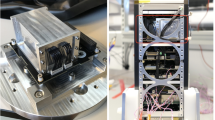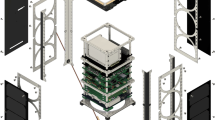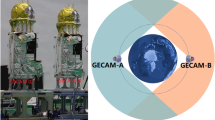Abstract
The Gamma-ray Burst Monitor consists of 12 sodium iodide and 2 bismuth germanate scintillation detectors designed to enhance the scientific returns from Fermi in the study of γ-ray bursts. It has a fixed non-paralyzing dead time of 2.604 μs for each detected event except for those in the overflow channel of the 12 bit analog to digital converter of each detector, which have a longer dead time of 10.42 μs. At very high counting rates the pulse pile-up effect in the detectors leads to spectral distortions and also to additional event losses. These effects are relevant for the spectral analysis of high-flux astrophysical events such as gamma-ray bursts, soft gamma repeaters and solar flares, as well as terrestrial gamma-ray flashes. In this paper we present the results of post-launch tests using engineering detectors and equipment on the ground, along with detailed simulations of these effects at very high counting rates. The simulations enable us to assess the qualitative and quantitative changes in spectral shapes and event losses at different count rates. The observed spectra at various count rates using high intensity radioactive sources such as Cs137 and Co60 agree well with the simulated spectra. We also re-test the analytical model developed previously to correct for the pulse pile-up effects in GBM detectors. We also study the expected spectral distortions of specific spectral models commonly used in GRB analysis, including the Band model and power-law models with and without a high-energy cutoff.























Similar content being viewed by others
References
Ackermann, M., et al.: ApJ 745, 144 (2012)
van der Horst, A.J., et al.: ApJ 711, L1 (2010)
Briggs, M.S., et al.: JGRA 115, 7323 (2010)
Burgess, J.M., et al.: ApJ 784, 17 (2014)
Preece, R.D., et al.: Sci. 343, 51 (2014)
Guiriec, S., et al.: ApJ 727, 33 (2011)
Burgess, J.M., et al.: ApJ 784, L43 (2014)
Guiriec, S., et al.: ApJ 725, 225 (2010)
Meegan, C.A., et al.: ApJ 702, 791 (2009)
Chaplin, V., Bhat, N., Briggs, M., Connaughton, V.: Nucl. Inst. Methods A 717, 21 (2013)
Leo, W.R.: Techniques for Nuclear and Particle Physics, pp 160–61. Springer (1994)
Theis, L.M., Persyn, S.C., Johnson, M.A., Smith, K.D., Walls, B.J., Epperly, M.E.: Paper #1217 (2006)
Leo, W.R.: Techniques for Nuclear and Particle Physics, pp 122–27. Springer (1994)
Gedcke, D.: Ortec Application Note AN63 (2007). http://www.ortec-online.com
Lucke, R.: Rev. Sci. Instrum. 47, 766 (1976)
Meeks, C., Siegel, P.B.: Am. J. Phys. 76, 589 (2008)
Cano-Ott, J.L., et al.: Nucl. Inst. Methods A 430, 488 (1999)
Lindstrom, R.M., Fleming, R.F.: Radioact. Radiochem. 6, 20 (1995)
Bolic, M., Drndarević, V.: Nucl. Inst. Methods A 482, 761 (2002)
Esmaeili-sani, V., Moussavi-zarandi, A., Akbar-ashrafi, N., Boghrati, B.: Nucl. Inst. Methods A 665, 11 (2011)
Knoll, G.F.: Radiation Detection and Measurement, 3rd ed. Wiley, New York (2000)
Rainwater, L.J., Wu, C.S.: Nucleonics 1, 60 (1947)
Müller, J.W.: Nucl. Instr. Methods A 301, 543 (1991)
Band, D., et al.: ApJ 413, 281 (1993)
Dwyer, J.R., Smith, D.M., Cummer, S.A.: S. A., Sp. Sci. Rev. 173, 133 (2012)
Ackermann, M., et al.: Science 343, 42 (2014)
Author information
Authors and Affiliations
Corresponding author
Appendix: A parameterization of spectral models
Appendix: A parameterization of spectral models
1.1 Power law model
-
1.
A = amplitude in photons s−1 cm−2 keV−1
-
2.
index λ,
-
3.
E = photon energy in keV
$$ f = A(E/100)^{\uplambda} $$
1.2 Exponentially cut-off power-law model
-
1.
A = amplitude in photons s−1 cm−2 keV−1
-
2.
E p e a k in keV
-
3.
index λ,
-
4.
E = photon energy in keV
$$ f = A \text{exp}\,[-E(2+\uplambda)/E_{peak}] (E/100)^{\uplambda} $$
1.3 Band’s gamma-ray Burst spectral model [24]
-
1.
A = amplitude in photons s−1 cm−2 keV−1
-
2.
E p e a k in keV
-
3.
low-energy index α,
-
4.
high-energy index β.
-
5.
E = photon energy in keV
Rights and permissions
About this article
Cite this article
Bhat, P.N., Fishman, G.J., Briggs, M.S. et al. Fermi gamma-ray burst monitor detector performance at very high counting rates. Exp Astron 38, 331–357 (2014). https://doi.org/10.1007/s10686-014-9424-z
Received:
Accepted:
Published:
Issue Date:
DOI: https://doi.org/10.1007/s10686-014-9424-z




